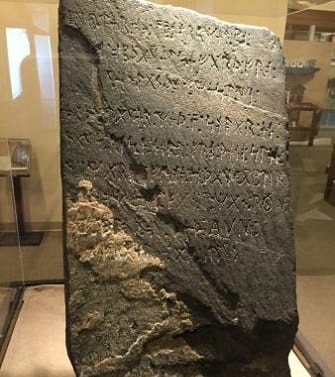What is the Kensington Runestone
Ever since 1898 when a farmer claimed to have found a mysteriously engraved stone under an uprooted tree near the town of Kensington Minnesota controversy has existed as to if it is an ancient Viking Runestone (Rune Stone) from medieval days or a hoax. The stone is dated 1362. If indeed genuine, it would mean that the Norse Vikings exploration of North America extended much further west than previously believed.Click here for a great selection of Amazon.com books about the Vikings.
On this page we will provide information on what the Kensington Runestone is, where it was found, who found it, and how it was discovered. We will also explain the research that has been done to determine if it is authentic.
Who Discovered the Kensington Runestone
A Swedish immigrant Olof Ohman is the farmer who claims to have unearthed the rune stone. He claims to have been clearing trees from a tract of land he had just acquired when he discovered the runestone lying face down tangled in the roots of a tree. Supposedly the farmer's ten year old son, Edward Ohman, noticed markings on the side of the stone. Olof would later say he thought he had found an "Indian almanac".Description of the Kensington Runestone
The Kensington Rune stone weighs approximately two hundred pounds (90 kg) and has dimensions of 30 by 16 by 6 inches (76 by 41 by 15 cm). There are runes engraved on the front and side. In 1907 a graduate student at the University of Wisconsin named Hjalmer R. Holand translated the writing on the stone. The writing describes an exploration by thirty men from Vinland to the west. It describes how they went fishing and somehow ten of the men were red with blood. After that is written, "Hail Virgin Mary, save from evil". The side of the Runestone reads "Have 10 men by the sea to look after our ship, 14 day journeys from this island year 1362."The Kensington Runestone - Real or Hoax
Although widely believed to be a hoax there are still many people who believe the stone is a genuine artifact. Soon after the stone was discovered its inscriptions were examined by Olaus J. Breda a professor of Scandinavian languages at the University of Minnesota. He declared the stone a forgery. Several other noted Scandinavian linguists also declared the stone a forgery as did Norway's leading archeologist Oluf Rygh.People who argue that the stone is in fact an ancient runestone note the following points.
- Geologist Newton Horace Winchell stated that based on the weathering of the stone the writing on it was approximately five hundred years old.
- The farmer, who found the stone, Olof Ohman, never tried to prosper from the find. Therefore what motivation would there be for this hoax?
- The waterway route the Vikings would have to have taken to reach Kensington has several other signs that may indicate Viking explorers were there. Boulders were discovered along rivers with holes similar in shape to those used by Vikings to moor their boats. Also, a fire-steel, which was a personal piece of equipment used by the Vikings to start a fire, was unearthed in Climax Minnesota.
